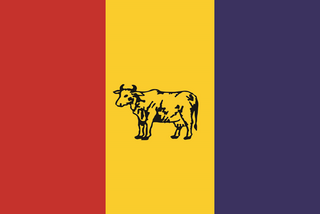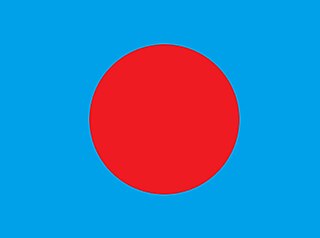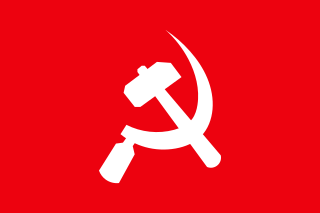
The Nepali Congress is a social democratic political party in Nepal and the largest party in the country. The party has 870,106 members as of the party's 14th general convention in December 2021, making it the largest party by membership in Nepal. In June 2023, the party started online membership since the emergence of youth leaders in vital posts to attract youths to the party. The party is led by former prime minister, Sher Bahadur Deuba since the party's thirteenth general convention in 2016. The party won 89 seats in the 2022 general election and is currently the largest parliamentary group in the House of Representatives.

The Communist Party of Nepal (Unified Marxist–Leninist) (Nepali: नेपाल कम्युनिष्ट पार्टी (एकीकृत मार्क्सवादी-लेनिनवादी), romanized: nēpāl kamyuniṣṭ pārṭī (ēkīkṛt mārksavādī-lēninavādī); abbr. CPN (UML)) is a communist political party in Nepal. The party emerged as one of the major parties in Nepal after the end of the Panchayat era.

The Rastriya Prajatantra Party is a constitutional monarchist and Hindu nationalist political party in Nepal.

There are three types of elections in Nepal: elections to the federal parliament, elections to the provincial assemblies and elections to the local government. Within each of these categories, there may be by-elections as well as general elections. Currently three electoral systems are used: parallel voting for the House of Representatives and provincial assemblies, single transferable vote for the National Assembly, and first-past-the-post for local elections.

The House of Representatives, commonly known as Pratinidhi Sabha, is one of the houses of the Federal Parliament of Nepal, with the other house being the National Assembly. Members of the House of Representatives are elected through a parallel voting system. They hold their seats for five years or until the body is dissolved by the President on the advice of the council of ministers. The house meets at the International Convention Centre in Kathmandu.
General elections were held in Nepal on 12 May 1991, to elect 205 members to the House of Representatives. The elections were the first multi-party elections since 1959 and were a result of the 1990 revolution forcing King Birendra to restore a multi-party system.
General elections were held in Nepal on 15 November 1994 to elect the House of Representatives. The election took place after the Nepali Congress government collapsed and King Birenda called new elections. The results showed that the Communist Party of Nepal won the most seats in the House of Representatives and Man Mohan Adhikari became Prime Minister at the head of a minority government.

Constituent Assembly elections were held in Nepal on 10 April 2008, having been postponed from earlier dates of 7 June 2007 and 22 November 2007. The Constituent Assembly was planned to draft a new constitution and therefore decide, amongst other things, on the issue of federalism. The number of eligible voters was around 17.5 million. The Constituent Assembly was originally set to have a term of two years.

Rastriya Janamukti Partry is a political party in Nepal. The party was founded on 6 May 1990 as Nepal Rastriya Janamukti Morcha. After unification with Rastriya Jana Party on 20 January 1992, the unified party adopted the name, Rastriya Janamukti Party.

The president of Nepal is the head of state of Nepal and the commander-in-chief of the Nepalese Armed Forces.

General elections were held in Nepal on 9 May 1981 to elect members of the Rastriya Panchayat. 80% of the seats were elected through adult universal suffrage; this was the first election through universal suffrage held in Nepal in 22 years. However, political parties were banned at the time, and the main underground opposition forces called for a boycott of the election.

Jhala Nath Khanal is a Nepalese politician who was the 35th Prime Minister of Nepal from February 2011 to August 2011. He was previously the chairman of the Communist Party of Nepal and Leader of the Constituent Assembly Parliamentary Party of the CPN (UML).

Kamal Thapa is a Nepalese politician belonging to Rastriya Prajatantra Party Nepal.

The Rastriya Panchayat was the legislature of the Kingdom of Nepal from during the panchayat era from 1962 to 1990. Following the 1960 coup by King Mahendra, the enactment of the Constitution of 1962, made the Rastriya Panchayat the supreme legislative body in the country, replacing the Parliament of Nepal.

Provinces of Nepal officially the Autonomous Nepalese Provinces were formed on 20 September 2015 in accordance with Schedule 4 of the Constitution of Nepal. The seven provinces were formed by grouping the existing districts. The current system of seven provinces replaced an earlier system where Nepal was divided into 14 administrative zones which were grouped into five development regions.

General elections were held in Nepal in two phases on 26 November and 7 December 2017 to elect the 275 members of the fifth House of Representatives, the lower house of the Federal Parliament of Nepal.

Provincial assembly elections were held in Nepal on 26 November and 7 December 2017 along with the general election. 330 seats in the seven newly created provincial assemblies were elected by first-past-the-post voting and 220 by proportional representation. The election was part of Nepal's transformation to a federal republic. Next Election will be held in 2022 unless dissolved earlier without completing the five years term. 2022 Nepalese provincial election will be the second election for provinces after completion of tenure of five years.

Communism in Nepal traces its roots back to the pro-democracy movement of 1951, and the subsequent overthrow of the autocratic Rana regime and the establishment of democracy in Nepal. The communist movement in Nepal has split into factions multiple times and multiple factions have come together into a single fold at times as well. It has a history of getting banned from open political discourse, as well as multiple instances of embracing guerrilla insurgency, most notably, the Maoist insurgency in the 1990s and early 2000s that led to the Nepalese Civil War, claiming at least 17,000 lives.

General elections were held in Nepal on 20 November 2022 to elect the 275 members of the House of Representatives. There were two ballots in the election; one to elect 165 members from single-member constituencies via FPTP, and the other to elect the remaining 110 members from a single nation-wide constituency via party-list proportional representation.

Provincial assembly elections were held in Nepal on 20 November 2022 along with the general election. 330 seats in the seven provincial assemblies will be elected by first-past-the-post voting and 220 by proportional representation.
















